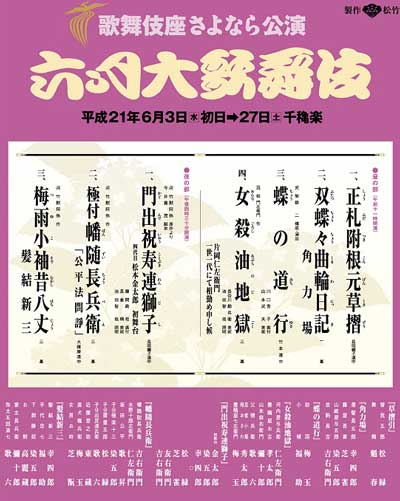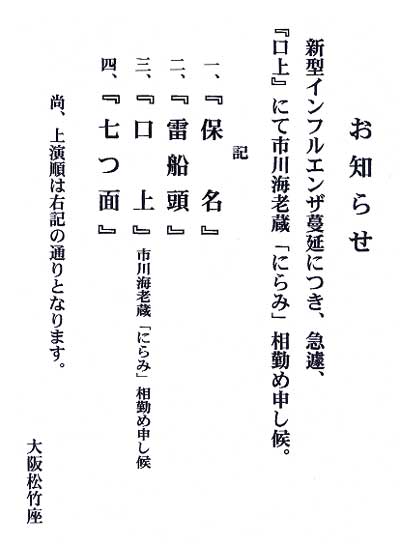| JUNE 2009 |
|
4 shows in T˘ky˘ (Kabukiza, National Theatre, Shinbashi Enbuj˘), 2 in Fukuoka (Hakataza), 3 in ďsaka (Sh˘chikuza, Wahha Kamigata Engei Hall, Sh˘chikuza) and 1 tour (Kansai)!
|
| Kabukiza (T˘ky˘) |  |
| Dates | 3 ~ 27 June 2009 (Rokugatsu ďkabuki) Kabukiza Sayonara K˘en |
| MatinÚe |
Futatsu Ch˘ch˘ Kuruwa Nikki (Sum˘ba) |
| Evening | |
| Casting |
Kataoka Nizaemon, Nakamura Kichiemon, Matsumoto K˘shir˘, Nakamura Shikan, Nakamura Shibajaku, Nakamura Baigyoku, Nakamura Kaishun, Nakamura Fukusuke, Kataoka Hidetar˘, Kataoka Takatar˘, Band˘ Yajűr˘, Nakamura Karoku, Onoe Sh˘roku, Ichikawa Somegor˘, Nakamura T˘z˘, ďtani Tomoemon, Ichikawa Komaz˘, Matsumoto Kintar˘ |
| Comments |
6th of the 16 Kabukiza Sayonara K˘en, the Kabukiza Farewell Performances, which will be held up to April 2010. Two important events in this program: the isse ichidai performance of Kataoka Nizaemon in the role of Yohei ("Abura no Jigoku") and the hatsubutai of Matsumoto K˘shir˘'s grandson Matsumoto Kintar˘ IV:
|
 |
|
|||
| Dates | 2 ~ 26 June 2009 (Rokugatsu ďkabuki) | ||
| MatinÚe | |||
| Evening |
Konoshita Kage Masago no Shiranami |
||
| Casting |
Nakamura Hashinosuke, Nakamura Senjaku, Kataoka Ainosuke, Nakamura Kantar˘, Nakamura Shichinosuke |
||
| Comments |
|
||
| Shinbashi Enbuj˘ (T˘ky˘) |
| Dates | 7 ~ 28 June 2009 (Rokugatsu ďkabuki) |
| Program |
Ninagawa Jűniya |
| Casting |
Onoe Kikugor˘, Onoe Kikunosuke, Nakamura Tokiz˘, Nakamura Kanjaku, Ichikawa Danshir˘, Ichikawa Kamejir˘, Ichikawa Danz˘, Nakamura Kinnosuke, Ichikawa Sadanji, Kawarasaki Gonjűr˘, Band˘ Shűch˘, Band˘ Kamesabur˘, Onoe Matsuya |
| Comments |
"If music be the food of love, play on!". The trouble caused by love is the theme of Shakespeareĺs play, a comedy with great depth. June at Shinbashi Enbuj˘ features an encore performance of a bold experiment. Ninagawa Yukio, known throughout the world for productions of Shakespeare and his blending of traditional and modern theatrical techniques will direct Kabuki actors in an adaptation of Shakespeareĺs "Twelfth Night". After being shipwrecked and being separated (presumably forever) from her twin brother Shiba Shuzennosuke (Sebastian), Princess Biwa (Viola) dresses as a young man, calls herself Shishimaru (Cesario) and takes service with ďshino Sadaijin (Orsino), who is in love with the fabulously wealthy Princess Oribue (Olivia). In the guise of Shishimaru, Princess Biwa becomes ďshino Sadaijin messenger to Princess Oribue, but she does not love him. Instead, she falls in love with Shishimaru and in turn, Princess Biwa falls in love with ďshino Sadaijin. But while these characters suffer for love, others lust after Princess Oribueĺs wealth. Her uncle T˘in Kanemichi (Sir Toby Belch) cannot stand to see the money leave the family and tries to get her married to the obnoxious And˘ Enchiku (Sir Andrew Aguecheek). Meanwhile, Princess Oribueĺs steward Maruo B˘dayű (Malvolio) is also in love with her, but he is so stuck-up and out of date that the people around him plot to make him think that Princess Oribue returns his love, only making him seem more ridiculous than ever. Ninagawa Yukio is famous throughout the world for his direction of new plays and the classics, using modern theatrical techniques and traditional aesthetics with a bold visual touch. For example, his production of "Macbeth" brought the play into the world of Japan and transformed the stage into a giant Buddhist altar, with mysterious old women praying throughout the play, as though the story of Macbeth took place within the altar as a message from the land of the dead. His production of "King Lear" brought together a famous English actor as Lear and a popular Japanese actor as the fool and was performed in England, while his production of "Oedipus Rex" combined an actress from the Japanese modern theater with an actor from Ky˘gen, the traditional comic style, and the production even went to Greece. This new production of "Ninagawa Jűniya", which was in fact premiered for the very first time in July 2005 at the Kabukiza, was staged in March 2009 in London at the Barbican Theater. The casting is the same as the March premiere, starring Onoe Kikunosuke as Princess Biwa and her twin brother Shuzennosuke, while Onoe Kikugor˘ plays Maruo B˘dayű and the jester Sutesuke. Also featuring Nakamura Tokiz˘ (Princess Oribue), Nakamura Kinnosuke (ďshino Sadaijin), Ichikawa Sadanji (T˘in Kanemichi), Ichikawa Danshir˘ (Isoemon) and Nakamura Kanjaku (And˘ Enchiku)! Source: Earphone Guide website |
| National Theatre (T˘ky˘) |
| Dates | 1 ~ 24 June 2009 (Rokugatsu Kabuki Kansh˘ Ky˘shitsu) |
| Program |
Kabuki no Mikata Kaka Saiyuki |
| Casting |
Ichikawa Ukon, Ichikawa Danjir˘, Ichikawa Emisabur˘, Ichikawa Emiya, Ichikawa Shun'en, Ichikawa En'ya |
| Comments |
Educational program at the National Theatre called Kabuki Kansh˘ Ky˘shitu ('Kabuki Appreciation Class'). This is a very interesting formula for the beginners because there is lively presentation on stage of Kabuki or some aspects of the art like music, stage tricks or fighting scenes, followed by the spectacular drama "Kaka Saiyuki".
|
| Educational Kabuki tour in Kansai | ||
| Date | 4 ~ 22 June 2009 | |
| Program |
Kabuki-he no Goannai |
|
| Casting | ||
| Comments |
34th edition of an educational Kabuki tour in Kansai. The first item is a speech about Kabuki and the second the drama "Sushiya": |
|
| Sh˘chikuza (ďsaka) |
| Dates | 3 ~ 10 June 2009 (Ichikawa Ebiz˘ Tokubetsu Buy˘ K˘en) |
| Program | |
| Casting | |
| Comments |
A special Buy˘ program, starring Ichikawa Ebiz˘:
|
 |
| Sh˘chikuza (ďsaka) |
| Dates | 13 ~ 14 June 2009 (Kiju Kinen Band˘ Takesabur˘ no Sekai) |
| Program |
Meibutsu Kenka Jaya (Otane to Sentar˘) D˘tonbori Kabuki no Nigiwai |
| Casting |
Band˘ Takesabur˘, Band˘ Shinsha, Nakamura Jűjir˘, Nakamura Kazutar˘ |
| Comments |
The actor Band˘ Takesabur˘ will celebrates his 77th birthday the 4th of August 2009. This program is Band˘ Takesabur˘'s kiju kinen performance. |
| Wahha Kamigata Engei Hall (ďsaka) | |
| Dates | 25 June 2009 (Tokiwakai) |
| Program |
Tabi Yakko Karigane Yamanba (Yama Meguri) Tanuki to Tanishi no Ise Mairi |
| Casting | |
| Comments |
6th edition of the program of the association Tokiwakai, which stars the disciples of Kataoka Gat˘ and Kamimura Kichiya. |
|
|
| Contact | Main | Top | Updates | Actors | Plays | Playwrights | Programs | Links | FAQ | Glossary | Chronology | Illustrations | Prints | Characters | Derivatives | Theaters | Coming soon | News |
